AUDUSD has broken Descending channel in upside
The Australian Dollar’s Boost: Commodity Prices and Economic Dynamics
The Australian Dollar (AUD) has recently shown signs of recovery, driven primarily by the rising prices of key commodities such as coal and copper. This improvement can be attributed to unexpected lending rate cuts by the People’s Bank of China (PBoC), which has had a ripple effect on global commodity prices. Let’s delve into the factors influencing the AUD’s performance and the broader economic implications.
Rising Commodity Prices and the Australian Dollar
The Influence of China’s Economic Policies
The People’s Bank of China recently made a surprising move by cutting key lending rates, a decision that has significant implications for the global market. China, being a major consumer of metals and energy, influences global commodity prices. When the PBoC reduced the one-year Medium-term Lending Facility (MLF) rate from 2.50% to 2.30%, it led to a surge in the prices of coal and copper. As a major exporter of these commodities, Australia benefits directly from such price increases. This, in turn, strengthens the AUD, reflecting the country’s economic reliance on its natural resource exports.

China’s economy is closely tied to Australia’s, given their strong trade relationship. Any economic shifts in China, whether positive or negative, have immediate effects on Australia. The recent rate cuts are intended to stimulate China’s economy, which has been facing challenges. By making borrowing cheaper, the PBoC aims to boost investment and consumption within China, thereby increasing demand for Australian exports.
Australia’s Economic Resilience
Australia’s economic stability also plays a critical role in the AUD’s performance. The Reserve Bank of Australia (RBA) has maintained a cautious approach towards its monetary policy, given the persistent inflationary pressures and a robust labor market. Unlike other central banks that are easing their policies, the RBA has opted to keep its policy tightening on hold. This hawkish stance supports the AUD, as investors view Australia as a stable and reliable market amidst global economic uncertainties.
The US Dollar’s Influence on AUD/USD
US Economic Indicators and Federal Reserve Policies
The performance of the AUD/USD pair is not only influenced by Australian factors but also by the strength of the US Dollar (USD). Recently, the USD has shown signs of weakening due to various economic indicators and expectations surrounding the Federal Reserve’s (Fed) monetary policies.

AUDUSD is moving in box pattern and market has fallen from the resistance area of the pattern
The US economy has been performing robustly, with key indicators such as GDP growth and employment data exceeding expectations. For instance, the US GDP grew at an annualized rate of 2.8%, surpassing previous readings and forecasts. Additionally, initial jobless claims fell, indicating a strong labor market. These positive economic signals have led to a reduced probability of the Fed implementing rate cuts in the near term. According to the CME Group’s FedWatch Tool, the probability of a 25-basis point rate cut at the September Fed meeting has decreased, reflecting the market’s confidence in the US economy’s resilience.
Impact on the Australian Dollar
Despite the strong US economic data, the AUD has managed to gain ground against the USD. This can be attributed to the higher commodity prices and the supportive stance of the RBA. Moreover, the Fed’s hesitation to cut rates further strengthens the AUD/USD pair, as investors seek higher yields in other currencies, including the AUD.
Global Market Movements and Their Effects on AUD
Economic Growth and PMI Data
Global market movements also impact the AUD, particularly through economic growth indicators and Purchasing Managers’ Index (PMI) data. For instance, the S&P Global US Services PMI increased significantly, indicating robust growth in the US services sector. Similarly, the Composite PMI rose, signaling sustained economic expansion.

AUDUSD is moving in Descending channel and market has fallen from the lower high area of the channel
In Australia, the Judo Bank Manufacturing PMI showed a slight improvement, although the Services PMI and Composite PMI experienced a decline. These mixed results highlight the varying economic dynamics within Australia, influencing investor sentiment and the AUD’s performance.
Trade Relations with China
Australia’s trade relationship with China remains a crucial factor. The recent rate cuts by the PBoC and other Chinese economic policies directly affect Australia’s export market. As China aims to stimulate its economy, the increased demand for Australian commodities like coal and copper provides a boost to the AUD. However, any negative developments in China’s economy could pose risks to Australia, given their intertwined trade relations.
Final Summary
The Australian Dollar’s recent recovery is a complex interplay of global economic dynamics, commodity prices, and central bank policies. The unexpected lending rate cuts by the People’s Bank of China have significantly influenced commodity prices, benefiting Australia’s export-driven economy. Meanwhile, the cautious yet supportive stance of the Reserve Bank of Australia has provided further stability to the AUD.

On the other hand, the US Dollar’s movements, driven by strong economic indicators and Federal Reserve policies, continue to impact the AUD/USD pair. Despite the strong US economy, the AUD has managed to hold its ground, supported by higher commodity prices and the RBA’s policies.
Understanding these factors is crucial for investors and market participants as they navigate the ever-changing landscape of global financial markets. The intertwined economic relations, central bank decisions, and commodity price fluctuations all play a significant role in shaping the future trajectory of the Australian Dollar.
Don’t trade all the time, trade forex only at the confirmed trade setups
Get more confirmed trade signals at premium or supreme – Click here to get more signals , 2200%, 800% growth in Real Live USD trading account of our users – click here to see , or If you want to get FREE Trial signals, You can Join FREE Signals Now!





